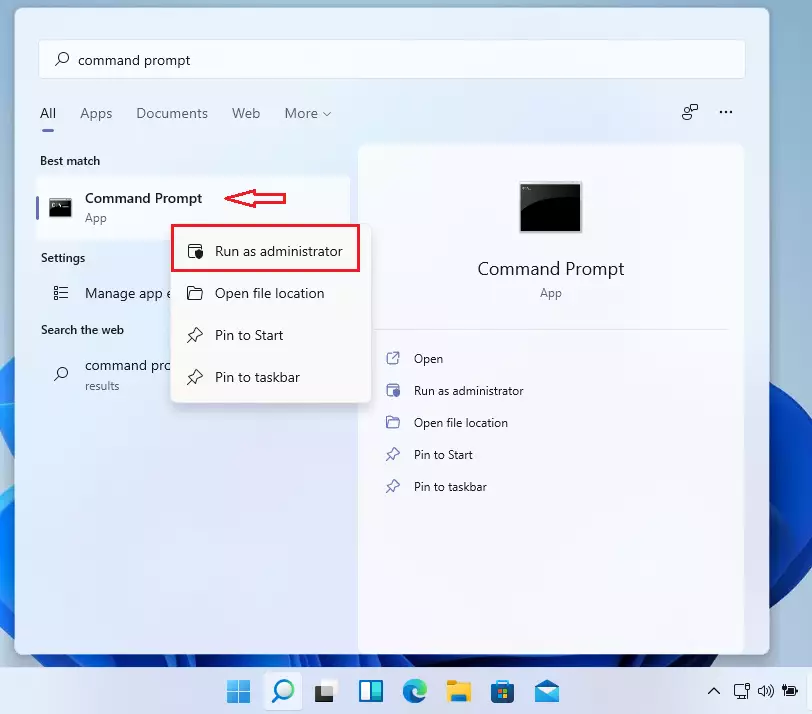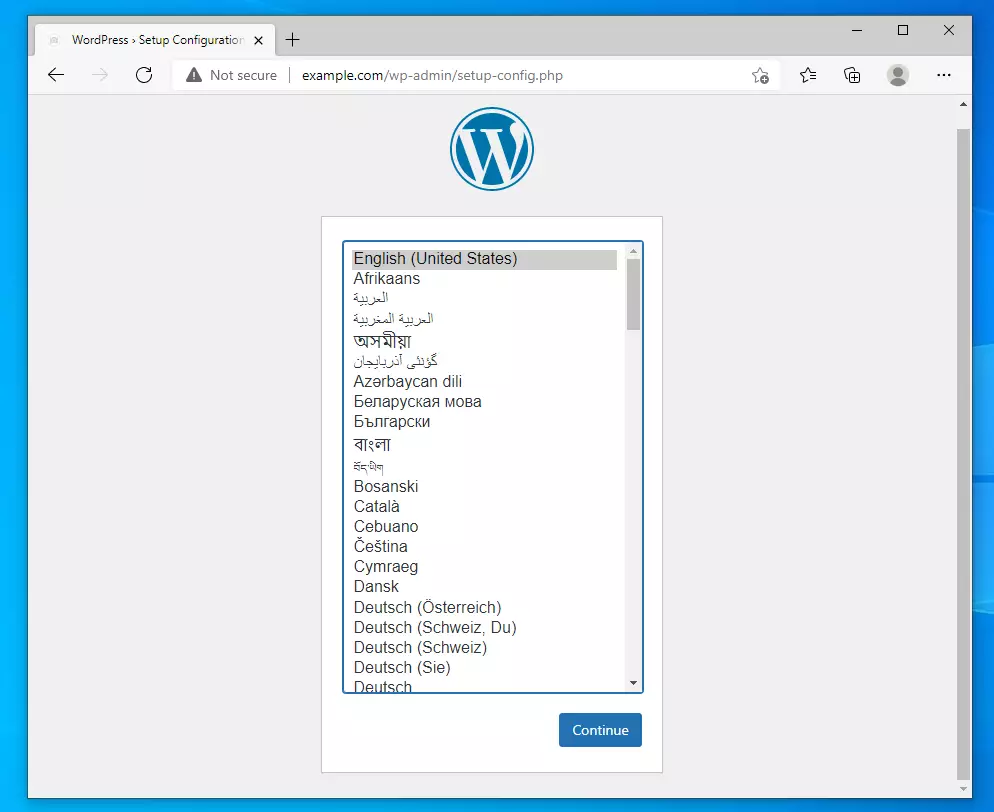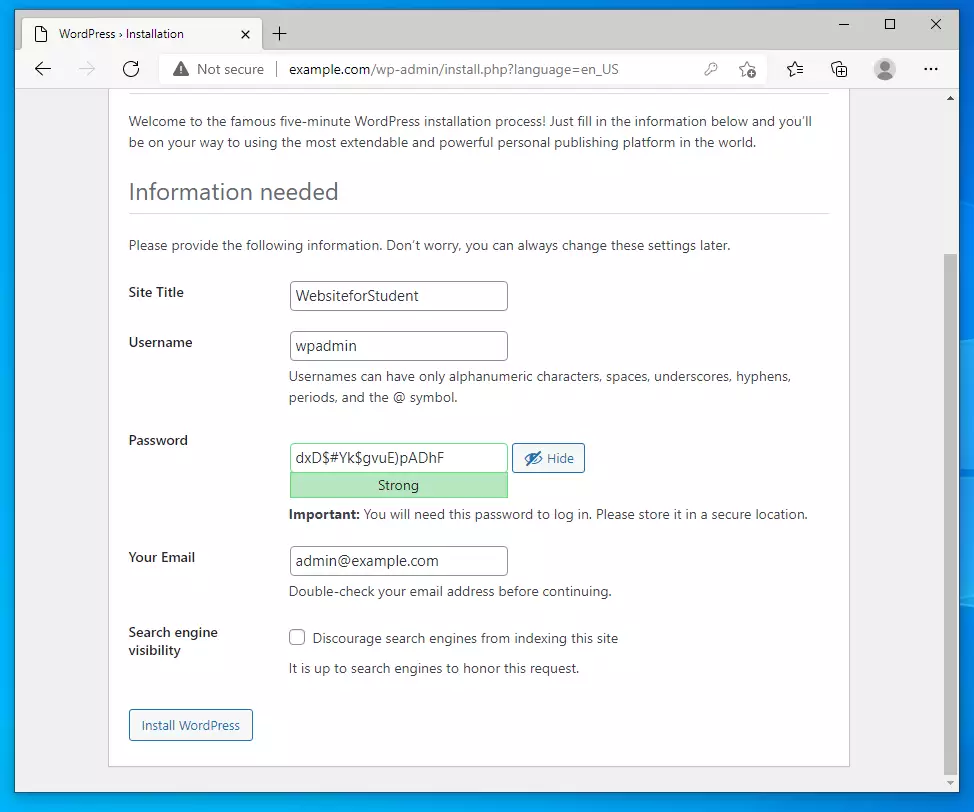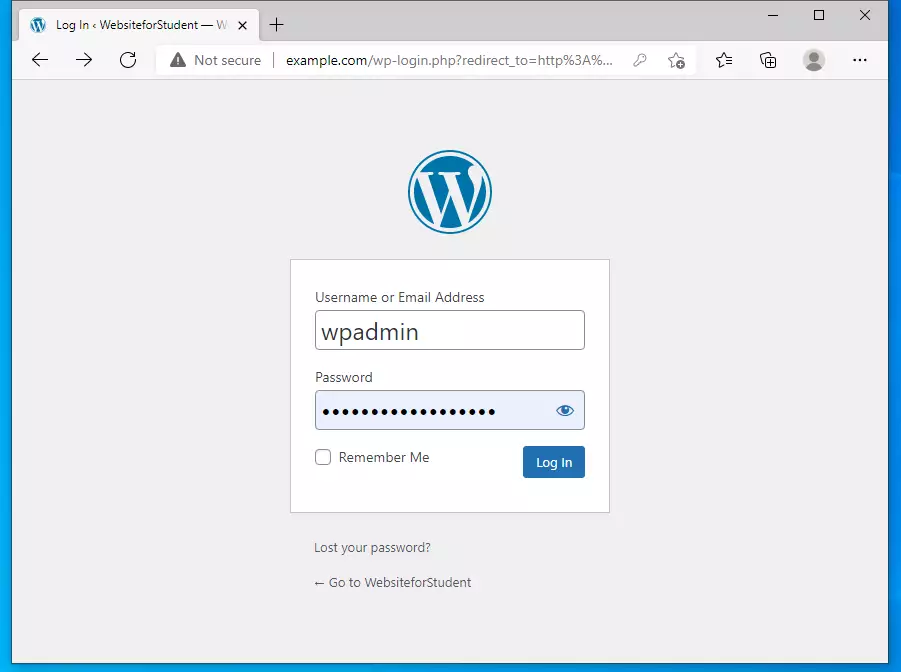This brief tutorial shows students and new users how to install WordPress on Windows 11 using Windows Subsystem for Linux (WSL).
You can now install and run WordPress directly from a Windows desktop or server via Windows Subsystem for Linux (WSL) without installing third-party apps or using a virtual machine. In 2017, Microsoft released WSL and WSL2, which lets developers run a GNU/Linux environment, including most command-line tools, utilities, and applications directly in Windows without setting up a virtual machine or dual-boot.
WSL2 is the new and improved version that comes with a performance boost and full system call compatibility, and it is built with a new architecture that delivers features that make WSL an amazing way to run a Linux environment in Windows.
With Windows 11, installing WSL is slightly different than in Windows 10. However, the steps below will show you how to do that.
To install and run WordPress on Windows 11, you must first install and enable WSL.
Install Windows Subsystem for Linux in Windows 11
To enable WSL in Windows, you must open the Command Prompt as administrator. Click on Start, then begin typing Command Prompt.
Next, right-click the Command Prompt app and choose to Run as administrator.

When the console opens, run the commands below to install Windows Subsystem for Linux (WSL):
wsl --install
Wait for WSL to be installed.
After installing, you should get a success message similar to the lines below:
Installing: Virtual Machine Platform Virtual Machine Platform has been installed. Installing: Windows Subsystem for Linux Windows Subsystem for Linux has been installed. Downloading: WSL Kernel Installing: WSL Kernel WSL Kernel has been installed. Downloading: GUI App Support Installing: GUI App Support GUI App Support has been installed. Downloading: Ubuntu The requested operation is successful. Changes will not be effective until the system is rebooted.
Restart your computer.
WSL should be installed and ready to use. When you want to update, simply run the commands below:
wsl --update
Install Specific Linux distro on Windows 11
Now that WSL is installed, you can install your own Linux distro. To list the available distributions to install, simply run the commands below:
wsl --list --online
You should then see all available distributions that can be installed on WSL.
NAME FRIENDLY NAME
Ubuntu Ubuntu
Debian Debian GNU/Linux
kali-linux Kali Linux Rolling
openSUSE-42 openSUSE Leap 42
SLES-12 SUSE Linux Enterprise Server v12
Ubuntu-16.04 Ubuntu 16.04 LTS
Ubuntu-18.04 Ubuntu 18.04 LTS
Ubuntu-20.04 Ubuntu 20.04 LTS
To install a Linux distribution from the list above, simply run the commands below using the distribution name. For example, to install Ubuntu 20.04, run the commands below:
wsl --install -d ubuntu-20.04
You should then get a message that the distribution is installed.
Downloading: Ubuntu 20.04 LTS Installing: Ubuntu 20.04 LTS Ubuntu 20.04 LTS has been installed. Launching Ubuntu 20.04 LTS.
After installing, you should get a Ubuntu command console with setup details.
Installing, this may take a few minutes.
Please create a default UNIX user account. The username does not need to match your Windows username.
For more information visit: https://aka.ms/wslusers
Enter new UNIX username: Richard
New password:
Retype new password:
passwd: password updated successfully
Installation successful!
To run a command as administrator (user "root"), use "sudo <command>".
See "man sudo_root" for details.
Welcome to Ubuntu 20.04 LTS (GNU/Linux 4.4.0-22000-Microsoft x86_64)
Some troubleshooting commands to run when you run into issues.
wsl --set-default-version 1 bcdedit /set hypervisorlaunchtype auto start
Now that Ubuntu Linux is installed and ready, continue below to install the LEMP server to run WordPress. First, install the Nginx HTTP Server.
Install Nginx HTTP Server
WordPress requires a web server to function, and Nginx is one of the most popular open-source web servers available today.
To install Nginx on Ubuntu, run the commands below:
sudo apt update sudo apt install nginx
After installing Nginx, the commands below can be used to stop and start Nginx services.
sudo service nginx stop sudo service nginx start
To test whether Nginx is installed and functioning, open your web browser and browse to the server’s IP address or hostname.
http://localhost

If you see the above page in your browser, Nginx works as expected.
Install MariaDB Server
You’ll also need a database server to run WordPress. A database server is where WordPress content gets stored.
A truly open-source database server that you can use with WordPress is the MariaDB database server. It is fast and secure and is the default server for almost all Linux servers.
To install MariaDB, run the commands below:
sudo apt install mariadb-server mariadb-client
After installing MariaDB, the commands below can stop and start the service and enable it to start when the server boots.
sudo service mysql stop sudo service mysql start
Next, run the commands below to secure the database server with a root password if you were not prompted to do so during the installation.
sudo mysql_secure_installation
When prompted, answer the questions below by following the guide.
- Enter current password for root (enter for none): Just press the Enter
- Set root password? [Y/n]: Y
- New password: Enter password
- Re-enter new password: Repeat password
- Remove anonymous users? [Y/n]: Y
- Disallow root login remotely? [Y/n]: Y
- Remove test database and access to it? [Y/n]: Y
- Reload privilege tables now? [Y/n]: Y
To verify and validate that MariaDB is installed and working, log in to the database console using the commands below:
sudo mysql -u root -p
Type the root password when prompted.

The server was successfully installed if you see a similar screen.
Install PHP and Related Modules
WordPress is a PHP-based application, and PHP is required to run it. Run the commands below to install PHP and related modules to support WordPress.
sudo apt install php-fpm php-common php-mysql php-gmp php-curl php-intl php-mbstring php-xmlrpc php-gd php-xml php-cli php-zip
After installing PHP, configure some basic settings required for WordPress to function properly.
For this tutorial, PHP 7.4 was installed. Based on your environment, another version of PHP might be installed. So verify that.
sudo nano /etc/php/7.4/fpm/php.ini
Below are good settings to configure for most WordPress websites.
file_uploads = On allow_url_fopen = On short_open_tag = On memory_limit = 256M cgi.fix_pathinfo = 0 upload_max_filesize = 100M max_execution_time = 360 date.timezone = America/Chicago
That should get PHP 7.4 installed with some basic settings to allow WordPress to function.
After setting up PHP, the command below can be used to stop and start PHP7.4 services.
sudo service php7.4-fpm stop sudo service php7.4-fpm start
Create WordPress Database
When all the servers are installed above, it’s time to begin setting up the WordPress environment. First, run the steps below to create a blank WordPress database.
Login to the MariaDB database console using the commands below:
sudo mysql -u root -p
Then, create a database called wpdb
CREATE DATABASE wpdb;
Next, create a database user called wpdbuser and set a password
CREATE USER 'wpdbuser'@'localhost' IDENTIFIED BY 'new_password_here';
Then, grant the user full access to the database.
GRANT ALL ON wpdb.* TO 'wpdbuser'@'localhost' WITH GRANT OPTION;
Finally, save your changes and exit.
FLUSH PRIVILEGES; EXIT;
Download WordPress
At this point, WordPress is ready to be downloaded and installed. Use the commands below to download the latest version of WordPress.
cd /tmp wget https://wordpress.org/latest.tar.gz tar -xvzf latest.tar.gz sudo mv wordpress /var/www/wordpress
Then, run the command below to allow the www-data user to own the WordPress directory.
sudo chown -R www-data:www-data /var/www/wordpress/ sudo chmod -R 755 /var/www/wordpress/
Configure Nginx VirtualHost
Below is where you configure the Nginx VirtualHost file for your WordPress site. This file defines how client requests are handled and processed.
Run the commands below to create a new VirtualHost file called WordPress in the /etc/nginx/sites-available/ directory.
sudo nano /etc/nginx/sites-available/wordpress
Below is a very good configuration setting for most WordPress sites on the Nginx server. This configuration should work great.
Copy the content below and save it into the file created above.
server {
listen 80;
listen [::]:80;
root /var/www/wordpress;
index index.php index.html index.htm;
server_name example.com www.example.com;
client_max_body_size 100M;
autoindex off;
location / {
try_files $uri $uri/ /index.php?$args;
}
location ~ \.php$ {
include snippets/fastcgi-php.conf;
fastcgi_pass unix:/var/run/php/php7.4-fpm.sock;
fastcgi_param SCRIPT_FILENAME $document_root$fastcgi_script_name;
include fastcgi_params;
}
}
Save the file and exit.
After saving the file above, run the commands below to enable the new site, then restart the Nginx server.
sudo ln -s /etc/nginx/sites-available/wordpress /etc/nginx/sites-enabled/ sudo service nginx restart
At this stage, WordPress is ready and can be launched by going to the server’s IP or hostname.
http://example.com
That should bring up the WordPress setup wizard.

Type in the database connection and continue.

Create a WordPress admin account and password, then click Install WordPress.

Log in with the account above, and you’re done.

That’s it!
Conclusion:
This post showed you how to install WSL 2 on Windows 11, install Ubuntu, and run WordPress. If you find any error, please report it in the comment form below.

Leave a Reply